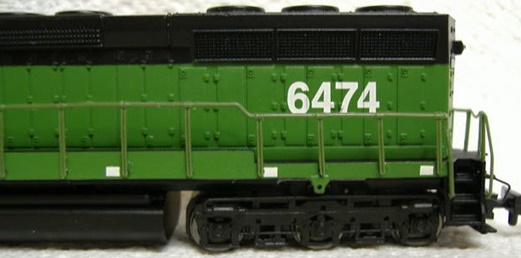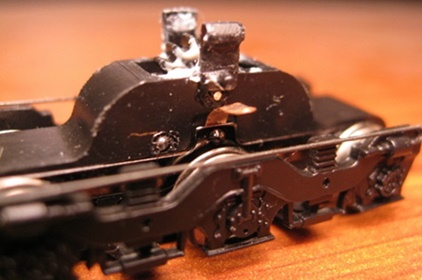



Introduced: 2004 (DCC-Ready Spectrum Version) and 2015 (DCC-Sound Version)
As noted above, there have been two radically different versions of this model (although both share the same shell and trucks).
Personally, I think the shells are very nice looking (fine detailing, crisp paint, etc). However, beauty is definitely in the eye of the beholder here, as I've read numerous complaints about the design of the shell (as compared to the prototype). Now, some of this may be quite subjective, so grain of salt and all that -
- The shell sits up too high relative to the trucks
- The first run lacked a blower duct on the fireman's side (fixed circa 2007)
- The fans and radiator grills look "odd"
- The geometry of the dynamic brake blister and radiator flares seems "off"
As mentioned above, the shell was modified after the first production run to include the correct "blower duct" on the left side - IE, a jog was added to the walkway (see below). Well, nice try Bachmann, but that still leaves plenty of other minor inaccuracies (real or imagined) to keep the rivet counters busy... But don't worry, they don't seem to be all that happy with Kato's SD45 either.

Internally, the first version's mechanism is similar in design to the one Bachmann used for their revised (2003) Dash-8 models, and employs most of the "state of the art" diesel model features -
The chassis is all-metal and split-frame. The 5-pole motor is open-sided and skew-wound (with dual flywheels). All wheels are geared and provide pickup (no traction tires). All gearing is plastic. The wheels are blackened and low-profile. The couplers are shell-mounted Rapidos (easily converted to MT's). Directional LED lights are mounted on either end of the chassis and connected via wires to the lightboard.
Bachmann touts these models as being "DCC Ready". And I guess they kinda/sorta are (insofar as contacts have been provided on the lightboard for DCC wiring, and room has been provided underneath said lightboard for a decoder). But no, definitely not a simple plug-n-play job. Worse still, there is absolutely zero guidance in the supplied documentation vis'a'vis decoder installation. Pretty much the only clues to be found are on the PC board itself - where the decoder contacts are numbered 1 through 8 (corresponding to the NMRA standards for decoder wiring). But given Bachmann's DCC-Ready marketing hype, said minimalistic support is a big slap in the face for their DCC users (particularly those who've never performed a "wired" decoder installation before).
Performance can be quite excellent - smooth, quiet, nimble throttle response, nice slow-speed creep, reasonable top-end speed, good pulling power, etc. Unfortunately, the wipers that conduct current from the trucks to the chassis are very poorly designed. Reminescent of the wipers on Life-Like's SD7/9 of the 90's, the flimsy / bendy metal strips employed on these models are a problem waiting to happen. Or for that matter, a problem that might have already happened (if you purchased one of the many poorly assembled SD45's that, out of the box, won't travel more than a foot without stalling). Making matters worse, the trucks employ axle-wiper pickup (as opposed to the more standard wiper-cup / needlepoint-axle scheme that pretty much everyone else uses). So, yeah, you're looking at frequent adjustments and cleaning in order to keep these things running.

Further, I find the lights used in these models to be a bit distracting. They look for all the world like very bright fluorescent lights (and decidedly unlike locomotive lights). Also, I've found that more often than not the wheel gauging on these models is off (generally too narrow). Nitpicks aside though, I think these first version SD45's are nice looking models that (generally speaking) run well. And given that they were/are available at steeply discounted prices (under $50), I definitely think there's a place for them in the N scale locomotive pantheon.
The second (2015) version has completely redesigned internals (including a factory-installed SoundTraxx DCC-Sound decoder). The chassis is all-metal and split-frame. The round "can" style motor is much smaller than on the previous version (and presumably coreless). There is only one flywheel (as opposed to the previous version, which had two). The trucks appear to be exactly the same as on the previous version (with the same axle-wiper pickups and bendy chassis wipers).
The decoder board is held to the chassis with two small screws (said screws also serve to transfer current from the chassis to the decoder board). Large capacitors on the underside of the board seat inside of round cut-outs in the top of the chassis. Tiny LED boards providing the directional lighting are screwed to either end of the chassis (with wires running to the main decoder board). Additional wiring from the decoder board runs down to the motor and to the speaker mounted inside the fuel tank -

Once again, all wheels provide pickup (no traction tires). All six axles are geared and all of the gearing is plastic. Wheels are blackened and low-profile. The couplers are shell-mounted E-Z Mates (Rapido-style couplers are included in the box should you want to go that route). Speaker holes are provided in the bottom of the fuel tank -

I purchased and returned two of these things before finally (on my third try) getting one that ran more or less OK. The thing is, out of the box these locos just flat out refuse to stay running (be it analog or DCC). Clean track, clean wheels, properly adjusted chassis wipers, none of it seems to matter. And the problem is particularly bad in reverse (where the locomotive will stutter along for an inch or two before finally going dark and giving up the ghost altogether - IE time to send out the five-fingered rescue crew).
Now, I don't know if it's the wheel blackening that needs to be worn off, or if it's the drivetrain that needs to be broken in (or some combination of the two), but in my case it took fully ten hours of roundy-rounding (alternating between forward and reverse) before performance finally smoothed out. And to actually get it to stay running during this break-in period, I had to crank the base track voltage on my DCC system all the way up to 20v (allowing the engine to run fast enough at full throttle such that it could power through all the stalls). Further, mine was delivered with zero lubrication on the gears. Consequently, about halfway through this break-in procedure I had to pull off the trucks in order to oil the bearings (to address some emergant screeching sounds).
Once suitably broken in, these are nice enough runners (for the most part). Throttle response is smooth, slow-speed creep is excellent, the top-end speed is nicely realistic, pulling power is super strong, the lighting looks great (especially as compared to the previous version) and the sound is flat out amazing - easily one of the best sounding diesels I've encountered in N scale. Unfortunately, sound decoders are fairly unforgiving when it comes to even small drops in track power. And given the iffy truck pickup situation, occasional hitches/mini-stalls seem to be inevitable (even after a lengthy break-in period). So, ultimately a pretty disappointing release from Bachmann.
Note - as of this 2016 writing, Bachmann's service department is offering replacement trucks for the DCC-Sound SD45 that supposedly solve its pickup issues. However, after comparing the so-called "new" trucks to the old ones I couldn't see any differences at all. And not surprisingly, performance on my SD45 did not improve one bit after installing said "new" trucks.
Prototype -
During the 60s and 70s, the race was on among locomotive manufacturers to develop more powerful locomotives for long-haul freight service. Among EMD's entrants into the fray was the "special duty" SD-45, a 3600-horsepower prime mover that went on to serve virtually every major railroad. With a V-20 engine and six-axle trucks for superior tractive effort, the SD-45 embodied the latest and greatest technological advances of its day.
First version features -
- DCC ready (sort of)
- Two piece die-cast main frame
- All-wheel pickup
- 5-pole, skew wound motor
- Dual machined brass flywheels
- White LED lighting
- Finescale detail parts
- N scale NMRA wheel flange profile
DCC-Sound version features -
- DCC-equipped for speed, direction and lighting
- Includes Sound Value SoundTraxx diesel package
- Prototypical prime mover, 3 air horns, and bell -- all in polyphonic 16-bit sound
- Die-cast split-frame / low-friction mechanism
- LED headlights
- E-Z Mate Mark II couplers
To remove the shell, use a small screwdriver (or toothpicks, or whatever), to spread the sides of the shell apart at the trucks. This will free the shell from the metal studs on the chassis that hold it in place. The shell should lift up and off readily at that point.
Grades: B (first version) and C (DCC-Sound version)